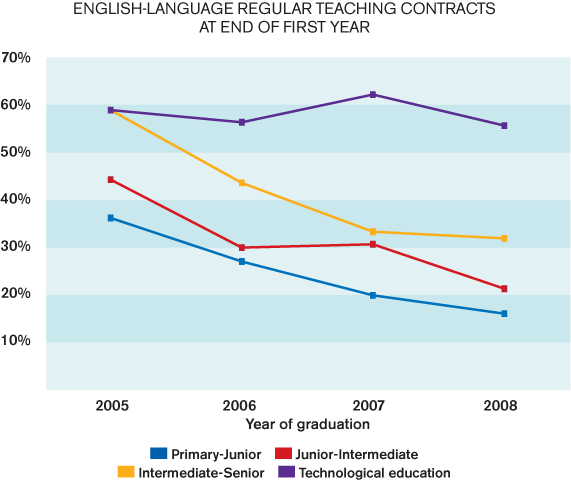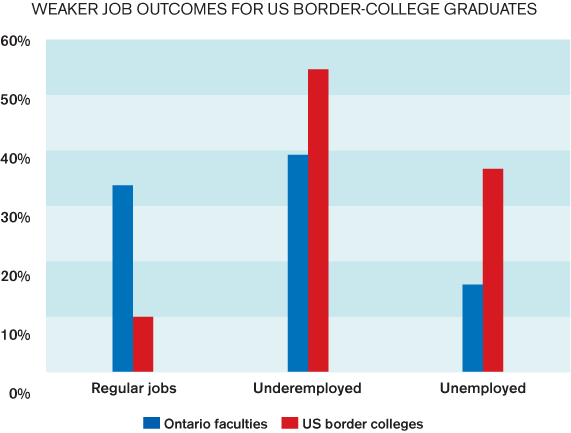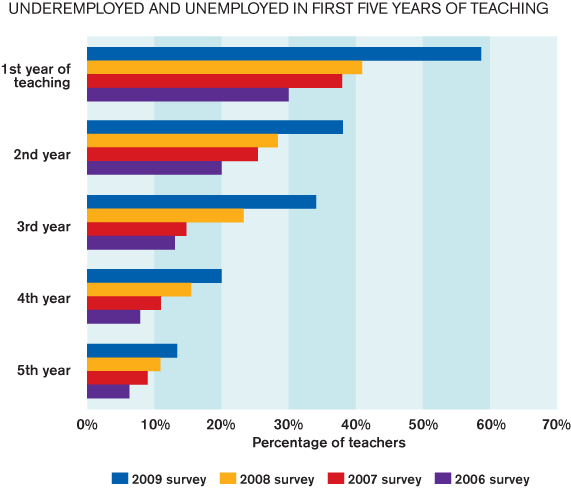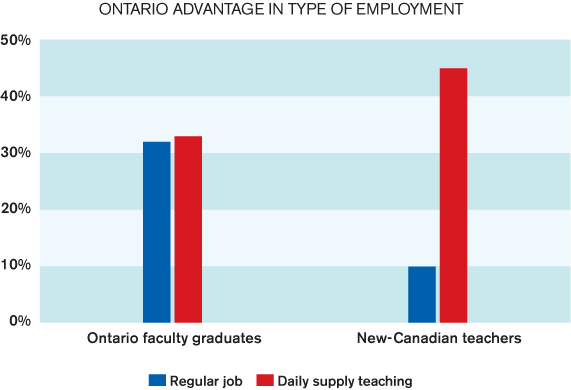New Teachers Determined Despite Tighter Job Market
by Frank McIntyre
Patience and flexibility are among the important attributes that new teachers can bring to their first classroom … and they are absolutely vital in the search for that first job.
The job market for new teachers reported in the 2008 Transition to Teaching study became even tighter in 2009. But most recent teacher education graduates show they have the commitment to stick with teaching as a career choice for the months or years needed to secure full employment as a teacher.
The spring 2009 Transition to Teaching surveys of teachers who graduated in 2008 and of new-to-Ontario teachers certified in 2008 and educated outside the province show the continuation of trends reported in recent years.
At the end of their first year in the teaching profession, only 31 per cent of new teachers reported that they had regular jobs, while underemployment rose to 42 per cent, part-time teaching climbed to 38 per cent and the number of new teachers who could only get daily supply teaching stood at 32 per cent.

Another 17 per cent of the 2008 graduates reported that, depite trying, they could not find a teaching job of any type in the first year following graduation, up substantially from the three to six per cent involuntary unemployment rates reported over the past four years.
English-language teachers in a crowded job market
English-language teacher graduates face longer wait times for the more secure regular full-time jobs to which most aspire. For the graduates of 2008 who defined themselves as actively in the teaching market in 2009, whether employed or still seeking employment:
- Under one in four (24 per cent) had regular job contracts by year end.
- About two in five (39 per cent) continued with daily supply teaching assignments only.
- Almost half (48 per cent) said they were underemployed during the first year.
- Another 21 per cent said they were unemployed as they could not find a teaching job of any type, even daily supply teaching.
English-language Elementary teachers face considerable competition for available teaching jobs.
It is extremely difficult to obtain any type of employment within any board. It is also almost impossible to get on the supply list.
Unemployed Primary-Junior 2008 graduate, Toronto region
Fully half of the employed English-language Primary-Junior teachers continued with daily supply teaching at the end of their first year in the profession. Only one in six (16 per cent) found regular teaching jobs. Almost three in five (58 per cent) said they were underemployed. And one in four (26 per cent) were unable to find a teaching job of any type.

English-language teachers in other divisions enjoyed somewhat stronger job outcomes. One in five (21 per cent) Junior-Intermediate graduates found regular teaching jobs, as did one in three (32 per cent) with Intermediate-Senior qualifications and more than half (55 per cent) of new teachers qualified in technological education.
Obtaining a teaching position in the first year of my teaching career
was a positive experience. I was offered a number of positions and accepted
the one I was most suited for.
Junior-Intermediate science teacher in regular job, southwest Ontario
I applied for multiple jobs and I am now 250 kilometres away from where I would like to be living.
Northwest Ontario secondary math and music teacher in regular teaching job
Daily supply teaching and underemployment reports are lower for each of these groups of teachers than for Primary-Junior-qualified teachers. Involuntary unemployment for graduates in these groups is up from previous years but remains less than among those with Primary-Junior qualifications.
Technological education first-year teachers continue to lead in each of the employment success measures.
I was fortunate to find a full-time position immediately after graduation with the board of my choice.
Regular technological education teacher, Toronto region
While only a minority of new English-language teachers throughout the province succeeded in landing first-year regular jobs, some regional variations are evident.
The highest reported regular job outcomes are in Toronto (40 per cent) and the northwest (37 per cent). The Toronto region outside the city itself follows at about one in five finding regular jobs (22 per cent), with the remaining areas significantly lower again – just 12 per cent of central, eastern and southwestern Ontario teachers reported regular jobs and 14 per cent in the northeast.
By contrast, 68 per cent of those who left the province to teach in their first year said they had regular teaching contracts.
I found a position quite easily overseas as they are looking for teachers all the time.
Intermediate-Senior English and math teacher in regular job, London, England
These English-language-teacher job outcomes reflect a gradual tightening of this employment market over several years. Regular teaching contracts have moved downward for all qualifications except technological education.

Part-time and daily supply teaching and underemployment gradually climbed for the same qualification groups over the same time period.
I have been working as an occasional teacher since graduation. I have had one long-term occasional position but am hoping to find permanent employment. As a supply I am able to work every day between two different school boards.
Intermediate-Senior daily supply teacher qualified in geography and physical and health education, central Ontario
It is extremely hard for new teachers to obtain positions due to a preference for teachers with experience, the limited number of openings each year and a saturation of retired teachers on the supply list.
Unemployed Intermediate-Senior science teacher, Toronto
Reduced French-language advantage
The long-established strength of the French-language teaching markets diminished somewhat for the graduates of 2008. Nonetheless, new graduates who can teach in French continue to enjoy more first-year success than others, with more than half of them finding regular teaching jobs by spring 2009.
I had my first long-term occasional position one week after completing my teacher education program. The vice-principal had contacted my university to find someone qualified to teach music.
Long-term occasional music teacher, Intermediate-Senior French-language program graduate
I was actually hired full-time in 2006 as I was enrolled in the BEd alternative program with Laurentian and there was a shortage of qualified French-speaking teachers. I have been at the same school for the last three years.
Regular Elementary teacher in French-language board, Mississauga
The rate of first-year regular job success for French-language teachers fell for the first time in six years – to 51 per cent from 72 per cent the previous year. Daily supply teaching at year end rose from eight per cent the previous year to 13 per cent, an increase, yet still just one-third the rate for English-language teachers.

The lower job-success rate is consistent across all component groups that constitute the Transition to Teaching definition of French-language teachers. Graduates of French-language teacher education programs reported a 47 per cent regular-job contract rate, new teachers hired by French-language school boards 45 per cent, and FSL teachers in English-language school boards 51 per cent.
I am teaching at a First Nation reserve school in Saskatchewan. I had to move to have a chance to get a teaching position. There are not enough opportunities in Ontario for new teachers.
Full-time term contract teacher, francophone Primary-Junior graduate
Despite these lower rates, just one in five or fewer of each of these sub-groups said they were underemployed in their first year (compared with about half of the English-language teacher respondents), and just two per cent reported involuntary unemployment.
Both French-language school boards and the English-language FSL markets absorbed available new teachers readily throughout most of the history of the Transition to Teaching study. One year of data does not necessarily identify a new trend. Surveys in 2010 and 2011 will tell whether the long-standing decline of the English-language teaching market is indeed broadening to the French-language markets.
The main trend over the eight years of this study is the substantial change in the English-language teaching market in the province – from 70 per cent of 2001 new teacher education graduates landing first-year regular jobs to 24 per cent of those joining the employment market in 2008.

Border-college job success declines further
US colleges in New York and Maine have educated more than 12,000 Ontario teachers since 2001. As the teaching-job market in the province tightened over the past four years, job-success outcomes for these border-college graduates have lagged behind those of the graduates of Ontario-based teacher education programs.
The 2009 survey shows that unemployment and underemployment are now very high for these US program graduates.
I was one of the lucky few from my class to even get on a supply-teacher list. I have found my first year teaching as a supply teacher very rewarding, but the limited number of jobs available is stressful.
Border-college graduate, daily supply teacher, Toronto

Only one in 10 of the 2008 border-college graduates actively teaching by year end reported that they found regular teaching jobs, and more than half (54 per cent) of them said they were underemployed during the 2008–09 school year. Another one in three (36 per cent) could not find a job of any type in the first year after graduating. Fully 90 per cent reported they were still unemployed at year end or underemployed during their first school year.
Ontario-faculty graduates had more than three times the success rate in finding regular teaching jobs (33 per cent), and their unemployment rate (15 per cent) was less than half that of the border-college graduates. Underemployment among employed teachers is about 40 per cent higher for the border-college graduates.
New graduates highly committed despite delayed entry
How long does it take new teachers to secure full employment in Ontario today?
Some teachers choose to continue with daily supply, part-time and/or long-term occasional assignments. The best measure for assessing the impact of the market on delaying full entry into the profession is reported underemployment and unemployment.

The latest underemployment and unemployment reports from the 2009 surveys of teachers in their first five years provide one answer to this question.
In 2009 only about two out of five first-year teachers found as much teaching employment as they wished, about two out of three second- and third-year teachers did so, as did four out of five fourth-year teachers and six out of seven fifth-year teachers.
I luckily got hired as a supply teacher right out of college. We were, however, told that we shouldn’t expect to get a full-time contract for at least seven years.
Daily supply teacher qualified in secondary math, southwest Ontario
Rates of teacher unemployment and underemployment increased in each of the last four years of the Transition to Teaching study.
Since 2006 under and unemployment combined rose from 30 to 59 per cent for first-year teachers, from 20 to 38 per cent for second-year teachers and has also increased for third-through-fifth-year teachers. Given this well-established trend, the wait time to settle fully into their careers may well be longer for the most recent graduates than for the second-through-fifth-year teachers surveyed in 2009.

Despite the challenging job market and high rates of unemployment and underemployment in the early years, most new teachers are strongly committed to the teaching profession.
Almost all first-year teachers in 2009 reported that they planned to teach in the next school year in Ontario (87 per cent) or outside the province (eight per cent).
My first year of teaching was actually six days of supply work. I hope there is more work available for me next year.
Unemployed FSL teacher, Toronto
Asked if they expect to still be in the teaching profession in five years time, more than nine out of 10 said they will definitely (76 per cent) or probably (16 per cent) continue in their chosen career. Some did not know. Fewer than two per cent said they will not or will probably not be teaching in five years.
I have found this year to be a very frustrating one. Despite feeling prepared and confident in my teaching skills, I have been unable to get a job. I will still work hard to achieve my goals as I am determined to make a career of this.
Primary-Junior part-time supply teacher, central Ontario
New Canadians struggle most in tighter job market
Ontario licenses more than 3,000 internationally educated teachers annually, about one out of four of whom is a new Canadian. Despite taking the first step in securing Ontario recognition of their teaching credentials, most new-Canadian teachers face challenges resuming their profession in this province.
For the eight years of this study, the gap between the job-success outcomes for new teachers educated in Ontario and those educated outside the province has been substantial. The disadvantage is most evident for new-Canadian teachers. While this gap decreased somewhat in the 2008–09 school year, as job success for Ontario-educated teachers fell for the fifth successive year, new-Canadian teachers continued to struggle to get their professional lives restarted in Ontario.

More than one out of three new-Canadian teachers licensed in 2008 report they could not find any teaching job at all in 2008–09. This involuntary unemployment rate is more than double that for Ontario-faculty graduates. Combined with the higher underemployment rate for new Canadians who were actively teaching, only one in 10 new-Canadian teachers on the job market last year found as much teaching employment as they wanted.
Very few new-Canadian teachers gain regular jobs in their first year of teaching in Ontario. Only one in 10 found this more secure form of employment in 2008–09, less than one-third the success rate for Ontario graduates.

Independent schools play a large role in the early Ontario employment of new-Canadian teachers. More than one in four teaching in the 2008–09 school year say they are employed in a private school. And three out of four who say they are in regular contracts found their jobs outside publicly funded schools.
Ontarians who complete their teacher education in other provinces, the US and elsewhere internationally also lag behind Ontario-faculty graduates on most job-success measures, as do teachers from other Canadian provinces who migrate to Ontario.
Tough job prospects worldwide
New teachers are facing tight job markets in a growing number of English-language jurisdictions around the world.
- The General Teaching Council for Scotland has revealed that the number of unemployed new teachers in Scotland has multiplied five times since 2005, with the number of new teachers finding permanent jobs now down to one out of five.
- Nine out of 10 teaching graduates in Queensland were not able to secure permanent jobs, according to the Australian state’s education ministry.
- The most recent figures from England’s Training and Development Agency for Schools show that just under 45 per cent of new Primary teachers in England have found permanent jobs.
New teachers successfully inducted
More than 18,500 new teachers have successfully completed the New Teacher Induction Program since it was introduced in the 2005–06 school year.
The mandatory program for new public-system teachers includes three elements: orientation, mentoring and on-the-job training. Teachers must receive two “satisfactory” ratings before receiving a notation of completion on their Certificate of Qualification and Registration.
Some 1,100 teachers completed the program in its initial year. The next two years each produced some 6,000 completions, with the number dropping to 5,435 in 2008–09.
Interest in teacher education waning
Teacher education applications wax and wane with the teaching employment market. Following three years of about 16,000 applicants to Ontario’s consecutive teacher education programs, the numbers have dropped over the past two years, falling to under 12,000 in 2009. The historic low for teacher education applications in Ontario was in 1997 and 1998, when the Ontario University Application Centre reported fewer than 8,000 applicants.

The number of Ontarians attending teacher education programs at US border colleges and subsequently gaining Ontario certification has also begun to decline. From a high of about 1,750 new teachers in 2006, the number of border-college graduates joining the profession annually in Ontario declined to about 1,350 by 2009.

If the current sharp drop in Ontario applicants to teacher education continues and approaches the historic lows of the 1990s – when the province’s teaching employment market was also very challenging for new teachers – the number of Ontarians who are certified each year as new teachers from Ontario faculties, border colleges and elsewhere internationally will decline further.
The Transition to Teaching study of new teachers in the 2008–09 school year examines the job-entry success and teaching experiences of teacher education graduates of 2004 through 2008 and new-to-Ontario teachers certified in 2008 and educated outside the province. Survey responses were received from 3,713 teachers.
The Transition to Teaching study is made possible by a grant from the Ontario Ministry of Education. This report does not necessarily reflect the policies, views and requirements of the Ministry.
